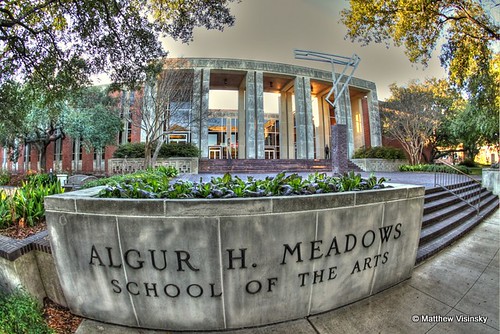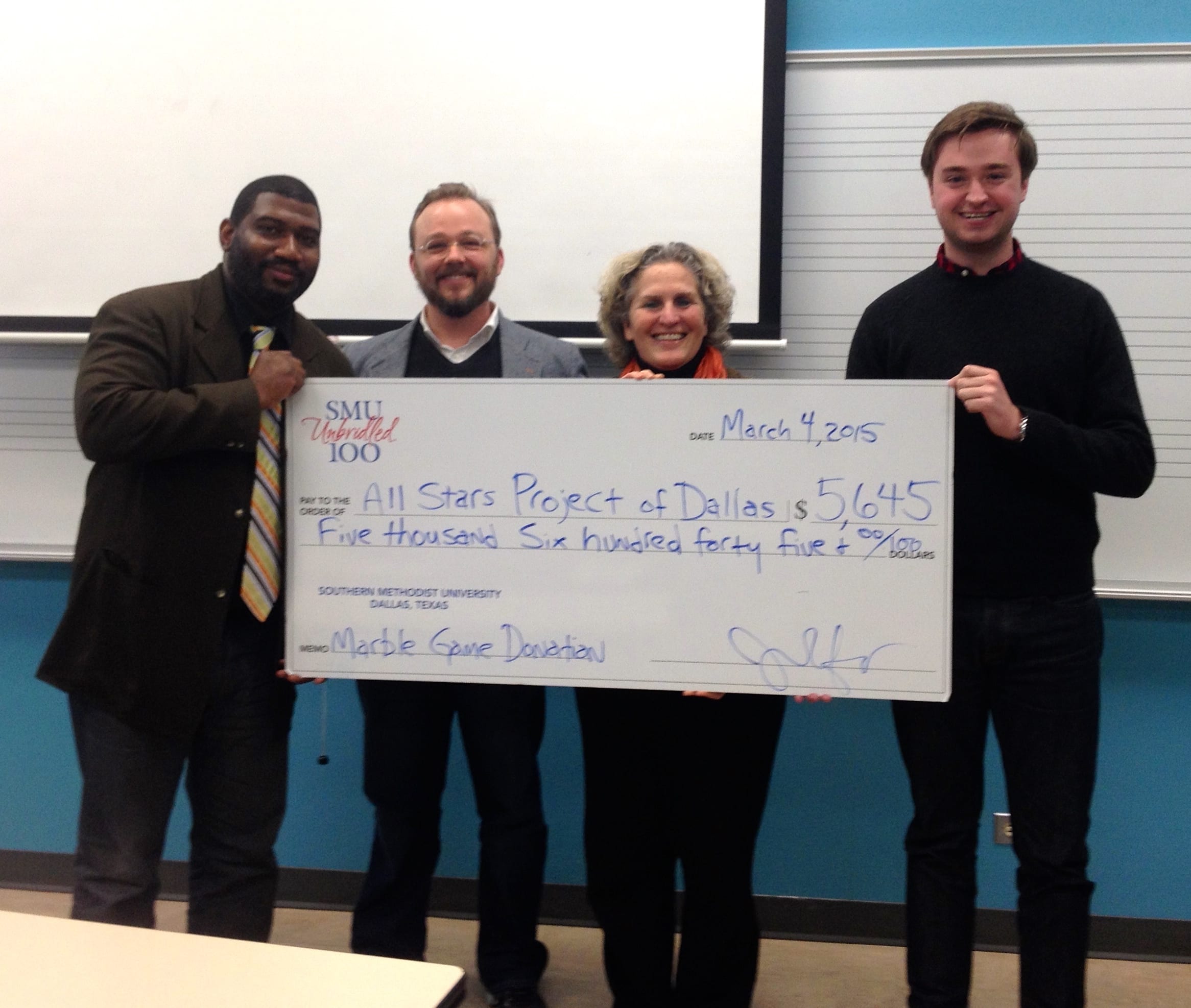The following interviews, conducted by Andrew McBride, seek to understand:
- If these creative entrepreneurs (or a nonprofit leader) sought capital in starting their organization
- What ways they may have done so, if applicable
- What advice they have for aspiring creative entrepreneurs.
This interview process is part of SMU Meadows’ class Creative Entrepreneurship and Attracting Capital.
James Jillson- Nasher Sculpture Center – 501(c)(3) 
Have you sought funding for your organization, and in what ways have you done so?
Yes, the bulk of my job at the Nasher involves raising funds from individuals for the Nasher. This includes amounts of $25 – $25,000. Generally, the ask is going to determine the best avenue to raise the funds. In dealing with small gifts communicating with an email or phone call makes responding more convenient for people. For larger gifts, it’s best to develop a relationship with the individual in person to show you care about their contribution.
What have you found to be the most effective ways of developing relationships with individual donors?
As a fundraiser, it’s your responsibility to figure out what their interests and passions are and match those interests with a fundraising opportunity at your organization. When meeting with potential funders, it’s important to go in with an open mind and to listen and let them guide the conversation. I have been in situations where I think a funder is going to like an opportunity, but end up not liking our idea at all. People who give to your organization are making an investment and you need to prove to them that you will spend their money responsibly.
What three pieces of advice do you have for aspiring arts and creative entrepreneurs regarding raising funds?
You don’t necessarily need to be an expert in what your fundraising for, but you need to be passionate about it. I’m very passionate about what the Nasher does and if you’re not passionate about something it makes it very difficult to fundraise for it, and I think that people pick up on that.
Next, treat donors the way you would want to be treated. The better job that you do of letting them know their specific impact, the more likely they are to keep supporting your organization. It is much easier and more lucrative in the long term to raise funds from previous donors than to be constantly searching for new contributors.
Lastly, I’ve found peer fundraising to be something that is very effective. Not everybody is comfortable with fundraising, but relying on your current donors or organizational leadership to ask friends and colleagues is extremely useful. People are usually more willing to give to somebody they know than a fundraiser they have not met.
Through interviewing Mr. Jillson of the Nasher Sculpture Center, I learned the importance of passion, networking, and listening. In working with many individuals to acquire funding for the Nasher, Mr. Jillson stresses the importance of know the interests of who you hope to fundraise from. In order to successfully acquire funds from individuals, one must be able to listen and adapt to their preferences. Since this is their money that they have earned, it’s important to show your appreciation for their giving to your organization. If you show that you will use their funds responsibly and that their gift will have a specific impact, people are more willing to donate. Similarly, Mr. Jillson outlined the importance of peer-fundraising and utilizing the networks of those who already contribute to your organization.
Stevan Gibson- The Lupus Foundation of America – 501(c)(3) 
Have you sought funding for your organization, and in what ways have you done so?
Yes. We receive support from pharmaceutical companies that develop drugs to combat Lupus. Individual donors that give to us either contribute through a family foundation or individual gifts. We also sponsor a walk program where people and sponsoring companies will contribute and raise awareness. Our organization also has a federal grant through the CDC that funds our education programs for people about Lupus.
How has the entertainment industry helped to raise awareness or attract capital for the Lupus Foundation?
Awareness is probably the best thing that the entertainment industry can do for us. Celebrities tend to have a much bigger microphone and larger effect in raising awareness. For Lupus, the biggest spokespeople have been Lady Gaga, since her aunt Joanne had died of the disease. She honored her by naming one album Joanne to spread awareness of Lupus’ effect. There are even celebrities who have Lupus-like Selena Gomez, and she has does a lot to educate people about the disease. Her journey fighting Lupus has been very public and raised awareness. We have also partnered directly with Hollywood on multiple projects. Most recently we have worked with the producers and writers on the Marvel show Agents of Shield to sponsor a contest where people may bid on a set visit and meet & greet with the cast. This helps us to raise awareness for the disease while also generating capital.
What fundraising and marketing strategies have you found to be most effective in raising funds or developing awareness for the disease?
Its most effective to be very diverse in your outreach, because you never know when something is going to resonate with somebody. Selena Gomez has a lot of young fans and most are unable to give money, but still help to spread awareness. Our partnership with the Agents of Shield producers has also been very effective in raising awareness and capital for our organization. Similarly, when I worked at the ALS association, the ice bucket challenge proved a diversified campaign that gained traction that we did not expect. One of the first patients to do the challenge had played baseball at Boston College, and knew some professional athletes from various Boston teams, who helped exponentially to raise awareness for the story.
What three pieces of advice do you have for aspiring arts and creative entrepreneurs regarding raising funds?
Always be able to tell your story in a succinic way, so that anybody can understand. It’s important to explain and define the story and show the overall impact of what you are doing before you start to approach anybody about a partnership.
Always keep your organization very diverse in your approaches. Social media has really changed the way that people gain information and developing effective communication over this medium has become a crucial tool for any type of organization.
You will never know how well something will work until you try it. People sometimes will not follow through with ideas that they aren’t sure about. It’s important not to be discouraged by failures and to not underestimate the impact of what may work.
By interviewing Mr. Gibson, I learned the importance of sharing your story in a way that clearly illustrated who you are and what you do. Especially in the entertainment industry, the story you share is extremely important when it comes to spreading awareness. Similarly, Mr. Gibson stresses the importance of social media in developing effective communication and in marketing in general. He also explained the importance of having a diverse approach to fundraising and awareness, because you never know when a stream of revenue may become unavailable. When deciding on a strategy to employ for fundraising, Mr. Gibson explains that you must not be afraid of failure, as you never know what may end up resonating the most with people.
Elizabeth Van Vleck – TITAS Presents — 501(c)(3) 
Have you sought funding for your organization, and in what ways have you done so?
Yes, at TITAS Presents we have a very diversified unearned income portfolio. For individual ticket sales, we include a donation form for people to donate after they purchase a ticket to our event. Our board of directors follow a give-get policy, where each of our 30 board members is responsible for giving at least $2,150 to the organization. We also allow for show sponsorships, where individuals or companies may sponsor a show around $5,000 – $15,000. The grant writing arm at TITAS applies for local, state, and national funding. Our corporate sponsor, American Airlines, helps us with transportation for our dancers, and the Sheridan Hotel Dallas, another sponsor, offers reduced rates to our performers as well.
What have you found to be most effective in raising funds and marketing for TITAS?
In terms of our institutional visibility, relationship building is key to our patron cultivation. And word of mouth and social media help to bring that visibility and credibility to our brand. It is extremely important to try to get our name out there all the time.
What three pieces of advice do you have for aspiring arts and creative entrepreneurs regarding raising funds?
Customer relationship management is vital in terms of knowing who your audiences are. Cultivating and nurturing relationships with donors through rigorous and passionate customer service is vital.
Be open to outside think tanks. Get different people and their perspectives from the community that are not necessarily in your world and ask them about what they hope to see in the organization.
Have a diverse portfolio of unearned income so that you are not just basing all your charitable contributions in one area in case that source of revenue disappears. Always be trying as much as possible to spread the word of your organization with passion and energy.
My interview with Ms. Van Vleck really illustrated for me the importance of customer relations in order to raise funds. By showing those who you will be serving that you value their input, the more people will give to your organization. She explained that passionate customer service is an essential element in cultivating and maintaining relationships with donors. Ms. Van Vleck also stresses the importance of having a diverse stream of unearned income as well as always being vigilant in regards to spreading the name of your organization. She also illustrated the importance of corporate partnerships, as they play an important role of support for their organization.




